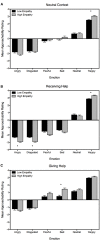The contribution of emotional empathy to approachability judgments assigned to emotional faces is context specific
- PMID: 26347680
- PMCID: PMC4541147
- DOI: 10.3389/fpsyg.2015.01209
The contribution of emotional empathy to approachability judgments assigned to emotional faces is context specific
Abstract
Previous research on approachability judgments has indicated that facial expressions modulate how these judgments are made, but the relationship between emotional empathy and context in this decision-making process has not yet been examined. This study examined the contribution of emotional empathy to approachability judgments assigned to emotional faces in different contexts. One-hundred and twenty female participants completed the questionnaire measure of emotional empathy. Participants provided approachability judgments to faces displaying angry, disgusted, fearful, happy, neutral, and sad expressions, in three different contexts-when evaluating whether they would approach another individual to: (1) receive help; (2) give help; or (3) when no contextual information was provided. In addition, participants were also required to provide ratings of perceived threat, emotional intensity and label facial expressions. Emotional empathy significantly predicted approachability ratings for specific emotions in each context, over and above the contribution of perceived threat and intensity, which were associated with emotional empathy. Higher emotional empathy predicted less willingness to approach people with angry and disgusted faces to receive help, and a greater willingness to approach people with happy faces to receive help. Higher emotional empathy also predicted a greater willingness to approach people with sad faces to offer help, and more willingness to approach people with happy faces when no contextual information was provided. These results highlight the important contribution of individual differences in emotional empathy in predicting how approachability judgments are assigned to facial expressions in context.
Keywords: approach/avoidance; emotion; emotional empathy; facial expression; prosocial behavior; situational context; social behavior.
Figures

Similar articles
-
Situational Context and Perceived Threat Modulate Approachability Judgements to Emotional Faces.PLoS One. 2015 Jun 29;10(6):e0131472. doi: 10.1371/journal.pone.0131472. eCollection 2015. PLoS One. 2015. PMID: 26121528 Free PMC article.
-
Judging approachability on the face of it: the influence of face and body expressions on the perception of approachability.Emotion. 2011 Jun;11(3):514-523. doi: 10.1037/a0022571. Emotion. 2011. PMID: 21668104
-
Happy but not so approachable: the social judgments of individuals with generalized social phobia.Depress Anxiety. 2009;26(5):419-24. doi: 10.1002/da.20474. Depress Anxiety. 2009. PMID: 19242987
-
Cognitive-behavioral models of social anxiety disorder.Psychiatr Clin North Am. 2001 Dec;24(4):753-71. doi: 10.1016/s0193-953x(05)70261-6. Psychiatr Clin North Am. 2001. PMID: 11723631 Review.
-
Strategic Regulation of Empathy.Trends Cogn Sci. 2021 Mar;25(3):213-227. doi: 10.1016/j.tics.2020.12.002. Epub 2020 Dec 30. Trends Cogn Sci. 2021. PMID: 33386247 Review.
Cited by
-
The relationship between theory of mind and moral sensitivity among Chinese preschool children: the mediating role of empathy.BMC Psychol. 2024 Mar 1;12(1):112. doi: 10.1186/s40359-024-01600-4. BMC Psychol. 2024. PMID: 38429758 Free PMC article.
References
-
- Batson C. D. (1998). “Altruism and prosocial behavior,” in The Handbook of Social Psychology, eds Gilbert D. T., Fiske S.T., Lindzey G. (New York: McGraw Hill; ), 282–316.
-
- Bellugi U., Adolphs R., Cassady C., Chiles M. (1999). Towards the neural basis for hypersociability in a genetic syndrome. Neuroimage 10, 1643–1657. - PubMed
LinkOut - more resources
Full Text Sources
Other Literature Sources

